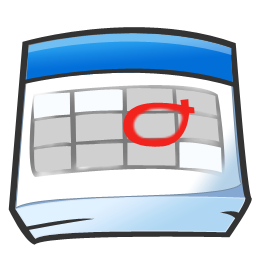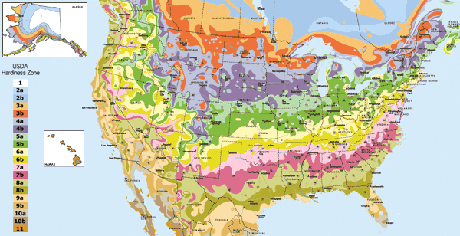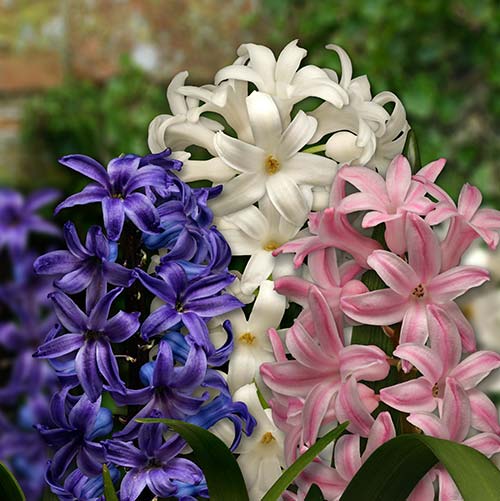If you’re looking for fragrance in your spring garden, make sure you plant plenty of hyacinths. This stately spring flowering bulb has a pleasant aroma that will turn heads, directing the eyes to a beautiful cluster of blooms. Hyacinth come in shades of white, salmon, pink, red, peach, orange, yellow, blue, purple, and lavender.
Hyacinth bulbs can be planted in beds and borders, and are perfect near an entryway where their good looks and sweet smell can be appreciated. The best show of flowers from hyacinth will be in their first year after planting. Because of this, many people treat them as annuals and replant each year.
Hyacinths of the Hyacinthus species open fully and look like little starfishes; don’t confuse them with another bulb that goes by the same common name, the petite grape hyacinth, which is actually Muscari.
When to plant:

Plant hyacinth bulbs in fall after the ground has cooled, which means late September to early October in the northern states (zones 3-5), and into November in the southern states (zones 6-8). Find your climate zone by zip code!
Where to plant:
Plant hyacinths in full sun or light shade and in well drained, preferably loamy soil. Because they bloom in early spring, hyacinths are often planted in the same garden beds as tulips and daffodils.
To create the most visual impact, plant hyacinth bulbs in a grouping of a dozen or more. The burst of color and fragrance will be sure to impress.
Planting depth:
Hyacinths are planted at a depth of six inches.The tip of the bulb should be pointed upward.
Spacing:
Space hyacinths about 4-6 inches apart.
How to plant hyacinth bulbs:
Let’s face it, most bulb planting methods have us spending a lot of time bending over or on our knees. The ProPlugger 5-IN-1 Planting Tool allows you to do most of the hard work of digging your bulb planting holes from a standing position.
To pull plugs, slide the 2″ or 4″ metal depth ring onto the bottom of the main tube to set the desired depth of the planting hole. Or to dig a 6″ deep hole, no depth ring is needed.
(Step, Twist and Pour) Step down on the foot pegs until the depth ring bottoms out against the ground. Give the 5-IN-1 a slight twist to break the soil plug free and pull straight up on the handlebars. To empty the plugs, simply turn the plugger upside down and pour the plugs out of the top of the tube.
The soil gets stored inside the tool as you work, enabling you to dig over a dozen planting holes, one right after another. Place the bulb in the planting hole, pointed tip facing upward. Fill in the hole with the soil you removed with the 5-IN-1. Firm the soil over the bulb with your foot.
Feeding:
When the leaf tips begin to poke out of the ground, apply a 5-10-10 fertilizer. About the time of flowering, top dress with a 0-0-10 or 0-0-50 fertilizer. Fertilize in the spring of each year with a 5-10-10 fertilizer or all purpose fertilizer used for feeding flowers. Mulching around the plants with aged compost or well rotted manure will achieve the same effect as a light feeding of fertilizer.
Hyacinth varieties:

- Single Hyacinths : (shown at top of page) This classic variety has full heads and stand out nicely in the garden.
- Double Hyacinths : (shown left) Get ready for fluffy whorls of colorful flowers, neatly arranged on 10-12 inch stems.
- Multiflora Hyacinths : Less formal than singles and doubles, these hyacinth bulbs produce a number of flower stalks with loose arrangements of flowers.
Hardiness zone:

Hyacinthsare hardy in zones 3-8; however, this varies by variety, so always check to make sure the hyacinths you purchase are hardy for your area.
Click on the map (right) to find your climate zone by zip code.
Disease and pest problems:
Like many bulbs and plants in general, fungus and disorders such as crown rot, can plague hyacinth. Good air circulation is a good preventive measure for virus and fungus problems.
Neil Moran is a horticulturist and author of three books on gardening. He is also the creator and author of the garden blog North Country Gardener
Be sure to check out the helpful information on our website, including other uses for the ProPlugger including:

